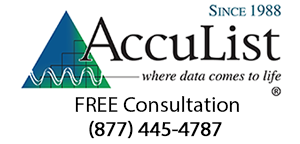P&C Insurance Embraces Direct Mail Response
Direct mail by property and casualty insurance clients continues as a staple of AccuList USA’s list brokerage and data services business, and so we were pleased to see a Valentine’s Day love note to P&C direct mail from the marketing consultants at IWCO Direct.
P&C Insurance Industry Loves Direct Mail
The IWCO post notes that nearly 400 insurance companies mailed more than 5.7 billion pieces of mail in 2017, according to Comperemedia. The property and casualty insurance category accounted for 53% of that volume, with more than 3 billion pieces of direct mail mailed by 110 companies. Of those direct mail packages, 95% were Marketing Mail (formerly called Standard Mail), mainly for acquisition (89%).
Mailings Reflect Ongoing Promotional Trends
Comperemedia and Competiscan data highlighted trends revealed by those direct mail packages, too. With 55% of policyholders likely to shop around for insurance as a policy comes up for renewal, smart insurance providers are taking a proactive approach and contacting policyholders in advance to remind them why they should remain with their current P&C insurance provider. Also to woo shoppers, both in acquisition and renewal, insurance promotions are direct about savings messages and competitor pricing comparisons. Finally, the industry’s continued embrace of direct mail does not ignore the digital revolution; in fact, direct mail packages are highlighting the industry’s growing self-service digital functionality for policyholders.
Basic Direct Mail Tactics That Up Response
Leveraging industry trends and success stories, IWCO lists three basic tactics proven to boost response for P&C acquisition and cross-sell mailings: 1) Comparison charts touting coverage benefits over those of top competitors, and an offer to match coverage pricing and benefits upon policy review if appropriate; 2) Promotional cards with a clear call-to-action via website, mobile app, and/or toll-free phone; and 3) An eye-catching personalized tagline. See https://www.iwco.com/blog/2018/02/14/pc-insurance-marketing-trends-valentines-day/
Millennial Attendees Reshape Event Success Strategies
As the millennial cohort expands event attendance, trade show and conference marketing clients, as well as performing arts marketing clients, with AccuList USA are beginning to change their targeting, messaging and event planning strategies to cater to a demographic that demands technological multi-channel savvy, interest-specific targeting, and experiential and interactive content. A recent post by UK-based Conference News highlights three strategies that event professionals can adopt to woo the millennial audience.
Offering Multiple Connection Points
While millennials are known for their social media, mobile-phone-addicted personae, studies show that these digital preferences can actually fuel greater live event interest; Conference News cites one survey showing 73% of millennials consider live event attendance as a way to express their beliefs and personality online. But it also means that event planners need to take cues from their digital experiences. Since millennials flock to online platforms that offer a nexus of various interests and connectivity, an event that focuses too narrowly can misfire. Conference News argues for a “multi-faceted event” and cites North Carolina’s Moogfest as an example. Moogfest is primarily a music festival, but, in 2016, it added a stage for workshops, installations and discussions of the current political climate. By combining art, activism, food/drink, and activities in one place, it addressed attendees’ multiple passions and created more social media fodder and buzz at the same time.
Playing With Non-Traditional Venues
Meeting the millennial demand for a multi-faceted event experience can require going beyond hotel conference rooms and exhibit spaces. In 2017, the demand for non-traditional spaces rose by 3.8%, notes the article. The right non-traditional venue will be a site that generates interest in itself while still providing comfort and meeting attendee requirements. Although on-site logistics may be more challenging, more event pros are betting that this venue creativity pays off in attracting and retaining audience.
Investing in Event Technology
Millennials are technically savvy and expect technically savvy event support. The Conference News article cites three event technology ideas likely to gain ground this year: 1) RFID (radio-frequency identification) wristbands, long in music festival usage, can work in other event milieus to speed up entry lines and to allow purchases without cash or cards; 2) Mobile Event Apps can let attendees craft customized experiences via eased navigation, personalized schedules, push notifications about upcoming activities, and social sharing with other attendees; and 3) Artificial Intelligence (AI) not only means chat bots to answer attendee questions but, in coordination with social-media-based event app info, can generate personalized on-site recommendations. See the complete article at http://www.conference-news.co.uk/blogs-features/top-3-event-trends-explore-2018
2018 Offers New Growth Opportunities for Publishing Marketers
There’s no doubt that AccuList USA’s business and consumer publishing clients face some pivotal audience- and revenue-building challenges in both print and digital marketing, but there are also growth opportunities in 2018. We note three potential positives recently highlighted by Publishing Executive magazine.
Quality Content Over Free Content
Audiences are increasing their demand for quality content, and advertisers are seeking publishers who can deliver that quality. There is a lot of untapped revenue potential for publishers who commit to quality, especially since the free-information era is ending as readers become wary of free but low-value content and increasingly willing to pay for reliable quality. For digital publishers, the downside of a shift to paid quality content can be a shrinkage of circulation, forcing them to balance potential gains in subscription revenue against lower page-views for ads. The Publishing Executive article offers various mitigating tactics: leaky paywalls; metered paywalls; charging only for premium content; allowing only paid subscribers to comment or participate in an online community; early access to certain articles for paid subscribers; access to paywalled content for subscription to a free newsletter, etc.
It’s All About Niches
With consumer access to vast amounts of information spewing into print, online, media and social every day, mass-market-oriented print and digital publications have been struggling, and niche publishers proliferating. Readers want to focus on what’s relevant to their specific interests, and many advertisers want to reach the right pool of people more than just the largest pool of people. The trick for publications is to embrace niche demand without sacrificing too much circulation. The Publishing Executive article offers some suggestions. Digital publications can create a product-within-a-product on the website, for example, with content targeted to a subset of the normal audience and attractive to new sponsors who want to reach that specific audience. For print publications, there are niche-targeted inserts, bonus sections, customized covers, polybagged special reports, or ad packages that combine a full-page ad in the magazine with a more in-depth cover wrap or insert for a special event or audience.
Demand for Brand Safety Grows
Brand advertisers have become concerned about aligning with publishers who tolerate fake news, violence, extremism, or other offensive content. The Association of Magazine Media recognized the danger and the opportunity in 2017 and released an ad campaign (“Better. Believe it.”) to highlight magazines’ quality content and brand safety. This means that respected publishers can court advertising revenue (and circulation) in 2018 by stressing brand quality and safety in their promotions. On that point, Publishing Executive quotes from an Advertising Age piece in which Shelagh Daly Miller of AARP declared: “Only when brands partner with reputable publishers can they have full confidence in where their ads are being placed. That’s a message that should be all over our industry’s media kits. And tattooed onto the foreheads of our ad reps.”
For more on publishing growth opportunities in 2018, read http://www.pubexec.com/post/6-growth-opportunities-publishers-2018/



